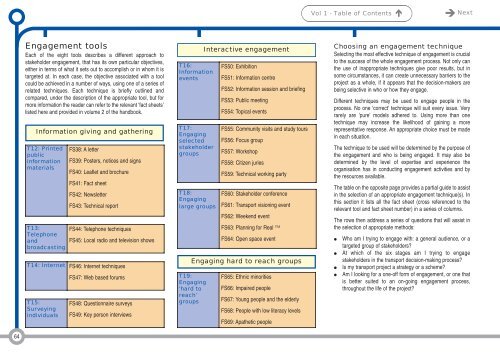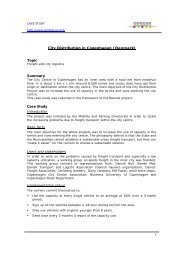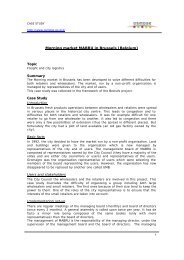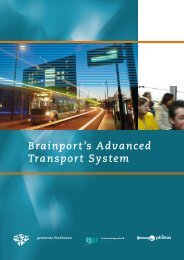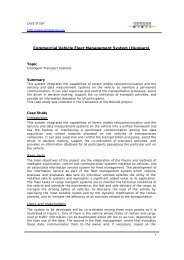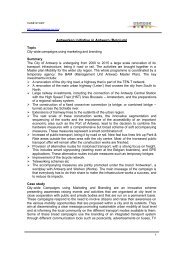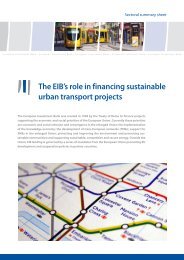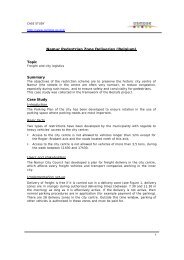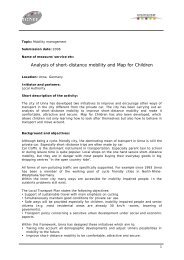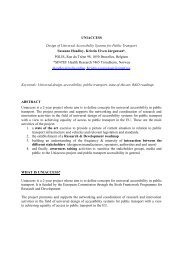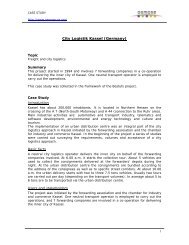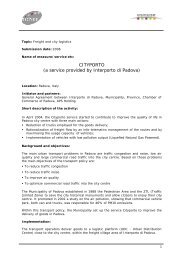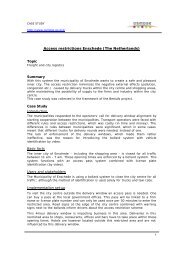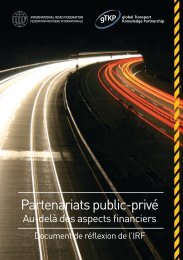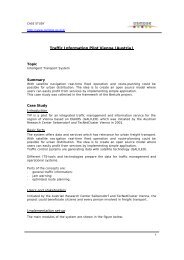Successful transport decision-making - Osmose
Successful transport decision-making - Osmose
Successful transport decision-making - Osmose
Create successful ePaper yourself
Turn your PDF publications into a flip-book with our unique Google optimized e-Paper software.
Vol 1 - Table of Contents <br />
Next<br />
Engagement tools<br />
Each of the eight tools describes a different approach to<br />
stakeholder engagement, that has its own particular objectives,<br />
either in terms of what it sets out to accomplish or in whom it is<br />
targeted at. In each case, the objective associated with a tool<br />
could be achieved in a number of ways, using one of a series of<br />
related techniques. Each technique is briefly outlined and<br />
compared, under the description of the appropriate tool, but for<br />
more information the reader can refer to the relevant ‘fact sheets’<br />
listed here and provided in volume 2 of the handbook.<br />
Information giving and gathering<br />
T12: Printed<br />
public<br />
information<br />
materials<br />
T13:<br />
Telephone<br />
and<br />
broadcasting<br />
T15:<br />
Surveying<br />
individuals<br />
FS38: A letter<br />
FS39: Posters, notices and signs<br />
FS40: Leaflet and brochure<br />
FS41: Fact sheet<br />
FS42: Newsletter<br />
FS43: Technical report<br />
FS44: Telephone techniques<br />
FS45: Local radio and television shows<br />
T14: Internet FS46: Internet techniques<br />
FS47: Web based forums<br />
FS48: Questionnaire surveys<br />
FS49: Key person interviews<br />
T16:<br />
Information<br />
events<br />
T17:<br />
Engaging<br />
selected<br />
stakeholder<br />
groups<br />
T18:<br />
Engaging<br />
large groups<br />
Interactive engagement<br />
FS50: Exhibition<br />
FS51: Information centre<br />
FS52: Information session and briefing<br />
FS53: Public meeting<br />
FS54: Topical events<br />
Engaging hard to reach groups<br />
T19:<br />
Engaging<br />
‘hard to<br />
reach’<br />
groups<br />
FS55: Community visits and study tours<br />
FS56: Focus group<br />
FS57: Workshop<br />
FS58: Citizen juries<br />
FS59: Technical working party<br />
FS60: Stakeholder conference<br />
FS61: Transport visioning event<br />
FS62: Weekend event<br />
FS63: Planning for Real <br />
FS64: Open space event<br />
FS65: Ethnic minorities<br />
FS66: Impaired people<br />
FS67: Young people and the elderly<br />
FS68: People with low literacy levels<br />
FS69: Apathetic people<br />
Choosing an engagement technique<br />
Selecting the most effective technique of engagement is crucial<br />
to the success of the whole engagement process. Not only can<br />
the use of inappropriate techniques give poor results, but in<br />
some circumstances, it can create unnecessary barriers to the<br />
project as a whole, if it appears that the <strong>decision</strong>-makers are<br />
being selective in who or how they engage.<br />
Different techniques may be used to engage people in the<br />
process. No one 'correct' technique will suit every issue. Very<br />
rarely are 'pure' models adhered to. Using more than one<br />
technique may increase the likelihood of gaining a more<br />
representative response. An appropriate choice must be made<br />
in each situation.<br />
The technique to be used will be determined by the purpose of<br />
the engagement and who is being engaged. It may also be<br />
determined by the level of expertise and experience the<br />
organisation has in conducting engagement activities and by<br />
the resources available.<br />
The table on the opposite page provides a partial guide to assist<br />
in the selection of an appropriate engagement technique(s). In<br />
this section it lists all the fact sheet (cross referenced to the<br />
relevant tool and fact sheet number) in a series of columns.<br />
The rows then address a series of questions that will assist in<br />
the selection of appropriate methods:<br />
<br />
<br />
<br />
<br />
Who am I trying to engage with: a general audience, or a<br />
targeted group of stakeholders?<br />
At which of the six stages am I trying to engage<br />
stakeholders in the <strong>transport</strong> <strong>decision</strong>-<strong>making</strong> process?<br />
Is my <strong>transport</strong> project a strategy or a scheme?<br />
Am I looking for a one-off form of engagement, or one that<br />
is better suited to an on-going engagement process,<br />
throughout the life of the project?<br />
64


